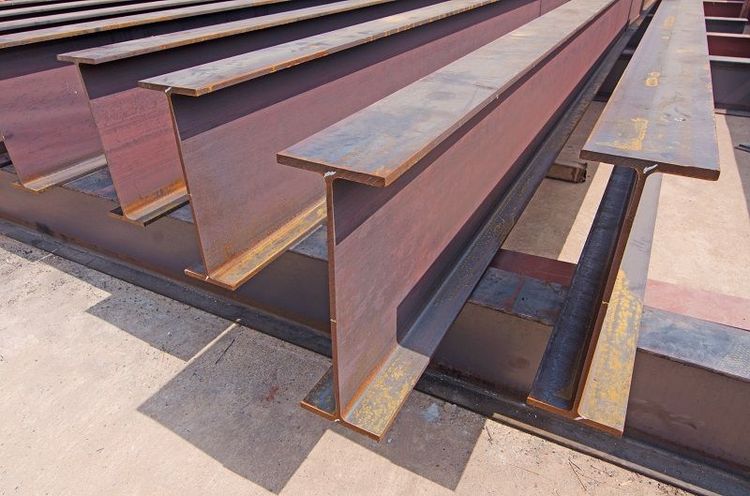I-beams are essential structural components used in a wide range of construction and engineering applications. They are known for providing strength, stability, and support. While I-beams come in various materials and fabrication methods, hot rolled steel is a popular choice due to its exceptional resilience. When steel beams are made, the way they are shaped by rolling affects how well they can support weight and handle forces. This rolling process changes the beam's shape and structure.
In beams like 'I' beams, which have a vertical part in the middle and horizontal parts at the top and bottom, the horizontal parts are responsible for handling most of the bending forces, while the vertical part mainly deals with the forces that try to shear or cut the beam.
Sometimes, during the rolling process, the shape of the beam changes from a solid, compact form to a thin-walled one with open spaces. This transformation makes the beam less stiff and less resistant to twisting forces.
To figure out how well different beam shapes perform, efficiency ratios are used. These ratios help them understand how the rolling process affects the beam's shape and how that, in turn, affects its strength and performance.
How hot-rolled steel makes I-Beams resilient?


There are specific properties of the beam's shape that are important. These properties include things like how much the beam can bend without breaking, how strong it is when it comes to resisting bending forces, and how well it can resist forces that try to shear or cut it.
In this blog, we'll explore how hot rolled steel contributes to the resilience of I-beams.
The basics of I-beams
I-beams, also known as H-beams or W-beams, have a distinctive 'I' shape when viewed in cross-section. This shape consists of a horizontal top flange, a vertical web, and another horizontal bottom flange. I-beams are commonly used to support heavy loads over wide spans, making them an integral part of many construction and engineering projects.
Load distribution
The primary purpose of I-beams is to distribute loads efficiently. The horizontal flanges provide resistance to bending forces, while the vertical web resists shear forces. This design allows I-beams to carry heavy loads without sagging or failing, making them ideal for supporting structures like bridges, buildings, and industrial equipment.
Versatile applications
I-beams are versatile and find applications in various industries, including construction, manufacturing, and transportation. They are used in everything from skyscrapers and warehouses to vehicle frames and shipbuilding.

Material matters
The material used in manufacturing I-beams greatly influences their strength and resilience. Hot rolled steel is a preferred choice for many applications due to its unique properties, which we will explore in detail.
Hot rolled steel: The resilient foundation
Hot rolled steel is the go-to material for manufacturing I-beams because it offers exceptional resilience and a range of advantages that make it well-suited for demanding structural applications.
Manufacturing process
Hot rolled steel is produced through a straightforward yet highly effective process. Steel billets are heated to high temperatures and then passed through a series of rollers to shape them into the desired profile, including I-beams. This hot rolling process allows for the creation of large, robust sections with minimal material waste.
Structural integrity
Hot rolled steel I-beams are known for their structural integrity. The hot rolling process results in a dense and homogeneous grain structure, enhancing their ability to withstand heavy loads and stress. This makes them ideal for long-span structures and high-load applications.
Resilience to deformation
One of the key attributes of hot rolled steel is its resilience to deformation. I-beams made from hot rolled steel can maintain their shape and structural integrity even under extreme pressures. They are less prone to bending, warping, or twisting, ensuring long-term stability and safety.
High strength
Hot rolled steel I-beams exhibit remarkable strength. They can carry substantial loads without yielding, making them suitable for critical applications like bridges, industrial facilities, and high-rise buildings. The high strength-to-weight ratio of hot rolled steel I-beams means that less material is needed to achieve the same structural integrity compared to some alternative materials.
Cost-effective
Hot rolled steel I-beams are cost-effective due to the efficiency of the manufacturing process and the material's longevity. They require less maintenance and replacement over their lifespan, reducing long-term costs.
Weldability
Hot rolled steel is highly weldable, allowing for the easy connection of I-beam sections on-site. This flexibility in joining makes it a practical choice for constructing large and complex structures.

Hot rolled steel vs. Other materials
While hot rolled steel offers significant advantages for I-beams, it's worth considering how it compares to alternative materials, such as cold-formed steel and timber.
Cold-formed steel: Cold-formed steel I-beams are manufactured at room temperature using a process that shapes steel sheets or strips. While they have their applications, they generally offer lower ductility and resilience compared to hot rolled steel I-beams.
Timber: Timber beams are a traditional choice for certain applications, but they lack the strength and fire resistance of hot rolled steel. Additionally, timber is susceptible to decay and insect damage, requiring more maintenance and shorter lifespans.
Conclusion
Hot rolled steel I-beams are the backbone of countless structures, providing the strength, stability, and resilience needed for diverse construction and engineering projects. Their ability to distribute heavy loads efficiently, maintain structural integrity, and resist deformation makes them indispensable in applications where durability and safety are paramount.
The hot rolling process results in I-beams that offer the ideal combination of strength, cost-effectiveness, and longevity. When choosing materials for your next construction project, consider the role of hot rolled steel I-beams and their contribution to the resilience of the structures they support. With hot rolled steel as the foundation, you can build structures that stand the test of time and remain steadfast in the face of demanding loads and environmental challenges.
Buy online
Mild SteelStainless SteelStructural SteelTMTCementJSW One MSME
About usBlogsSitemapJSW One TMTPolicy
Terms & conditionsPrivacy policyReturn policyBanking partner


 +91 7208055523
+91 7208055523
 Help & support
Help & support
